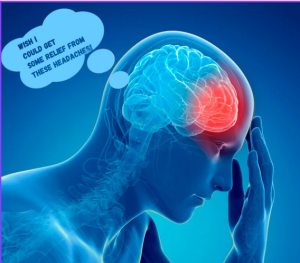Head and Jaw
- Headaches: Yes, physical therapy can help your acute and chronic headaches. There are 14 different types of headaches, as defined by the international headache society. The signs and symptoms of many of them overlap, so you may be experiencing a mixed headache type.
- A cervicogenic headache is one that arises from your neck and causes one sided head pain, commonly behind and around your eye. An evaluation of your symptoms and the upper part of your neck will allow us to determine if you are suffering from cervicogenic headaches. We will check to see if you have restricted upper neck motion, we can reproduce your headache pain with pressure over the upper neck, just under the base of your skull; the pain does not switch sides during the episode of headache pain, the pain is aggravated by head and neck motion or sustained postures. If you do, we will utilize spinal manipulation, mobilization and a combination of soft tissue techniques and exercises to normalize the mobility and stresses on your neck, which will decrease the frequency, duration and intensity of your headaches.
- Migraines are a little more complex in the underlying causes and triggers. However, when you break down the neural pathway of head, neck and face pain, this reveals the commonality in almost all headache types, which allows us to treat the underlying nerve activity contributing to you experiencing migraine symptoms. Our approach to evaluating and treating the neurologic, muscular and vascular systems together allow us to have a positive effect on reducing the frequency, duration and intensity of your migraines. The combination of spinal manipulation and dry needling help to decrease the pain and restore motion and extensibility of the neck. Adding electric dry needling helps to balance some of the altered neuro-chemical transmitters responsible for triggering and maintaining your headaches. The more painful stimulus or triggers we can eliminate or greatly decrease, the less frequent your migraine threshold will be exceeded, and the happier you will be!
- Tension type headaches are typically experienced on both sides of your head in the temple, forehead and even into the jaw. These headaches, as the name indicates they are typically brought on by stress and increased tension in the muscles of the head, neck, jaw, face, upper back and shoulders. A thorough evaluation of strength, range of motion, muscle tension, movement patterns of all the previously mentioned areas, discussion about your postures throughout a normal day and week, as well as general stress and health levels will give us insight as to the best treatment approach to positively affect your headache symptoms.
- Benign paroxysmal positional vertigo (BPPV): It results from the crystals in your inner ear either being stuck, or loose floating around in one of the canals. These crystals are part of a complex system within the inner ear along with 3 different canals filled with fluid and sensory receptors. In a normal functioning system your brain receives equal and opposite signals from each ear. When the crystals in one ear are out of place, your brain receives differing signals because the crystals typically keep moving within the fluid of the canal, telling your brain that you are still moving, in fact spinning because one ear is moving more than the other. This is what underlies the spinning and dizzy sensations experienced from position changes. There are several screening tools to determine if your dizziness is in fact BPPV, and where the crystals are. Once this is determined positional techniques are used to help move the crystals back to where they should be, and in more rare cases, to free them up if they are stuck.
- Temporomandibular Joint Dysfunction (TMD) Sometimes also known as TMJ
- There can be multiple underlying causes of TMD resulting in painful chewing, talking and yawning. Dry needling, joint mobilization and manipulation, IASTM and exercises help to restore normal mechanics of the joint and decrease or eliminate the pain.

 Our
Our